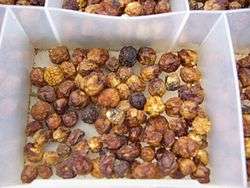Bush tomato



The term bush tomato refers to the fruit or entire plants of certain nightshade (Solanum) species native to the more arid parts of Australia. While they are quite closely related to tomatoes (Solanum lycopersicum), they might be even closer relatives of the eggplant (S. melongena), which they resemble in many details. There are 94 (mostly perennial) natives and 31 (mostly annual) introduced species in Australia.[1]
Bush tomato plants are small shrubs whose growth is encouraged by fire and disturbance.[1] The fruit of a number of species have been used as food sources by Aboriginal people in the drier areas of Australia.[1] They have a very strong flavor and scent when ripe and fresh, so that one can actually smell a richly fruiting specimen from quite a distance.
A number of Solanum species contain significant levels of solanine and as such are highly poisonous.[1] It is strongly recommended that people unfamiliar with the plant do not experiment with the different species, as differentiating between them can often be difficult.
Some of the edible species are:
- Solanum aviculare Kangaroo Apple[2]
- Solanum centrale, also known as Desert Raisin,[1] Bush Raisin or Bush Sultana, or by the native name kutjera
- Solanum chippendalei Bush Tomato, Named after taxonomic botanist George Chippendale[1]
- Solanum coactiliferum Aborigines roasted the fruit before eating.
- Solanum diversiflorum Bush Tomato, Karlumbu, Pilirta, Wamurla[1]
- Solanum ellipticum Potato Bush, Very similar to S. quadriliculatum which is poisonous.[1]
- Solanum laciniatum Kangaroo Apple.[3]
- Solanum orbiculatum Round-leaved Solanum[1]
- Solanum phlomoides Wild Tomato.[1]
- Solanum vescum
In 1859, the Aborigines were observed burning off the outer skin of S. aviculare as the raw state would blister their mouths.[4] Aborigines eat the fruit of S. centrale raw or put it on the hot earth by the fire, sprinkle some water on the fruits and cover them up to cook them. S. chippendalei is consumed by first splitting the fruit, scraping the centre out and eating the outer flesh as the seeds and surrounding placenta are bitter.[1] S. diversiflorum is roasted before being eaten or dried.[1] Fruit of S.orbiculatum is edible, but the fruit of the large leafed form may be bitter.[1] Fruit of S. phlomoides appears to be edible after the removal of seeds and roasting or sundrying.[1]
Mardu people would skewer them and dry them so the food was readily transportable. In Mardu they are known as wamurla, while the Warlpiri call them wanakiji.
In the Central Australian language of Arrernte, the species are distinguished. S. ellipticum and/or S. quadriloculatum are called merne awele-awele, S. cleistogamum is'merne mwanyerne, and S. centrale is merne akatyerre. The Arrernte term merne means "fruit or nut".
S. aviculare contains solasodine, a steroid used in the manufacture of oral contraceptives.[2]
References
- 1 2 3 4 5 6 7 8 9 10 11 12 13 14 Moore, Philip A Guide to Plants of Inland Australia (2005), Reed New Holland, Sydney, ISBN 1-876334-86-X
- 1 2 Robinson, Les Field Guide to the Native Plants of Sydney (1991), Kangaroo Press, Pymble, NSW. 3rd Edition, ISBN 0-7318-1211-5
- ↑ Donaldson, Stuart (16 December 2003). "Solanum laciniatum". Growing Native Plants. Australian National Botanic Gardens. Retrieved 28 June 2012.
- ↑ Bunce, Daniel Travels with Dr. Leichhardt,(1859), London